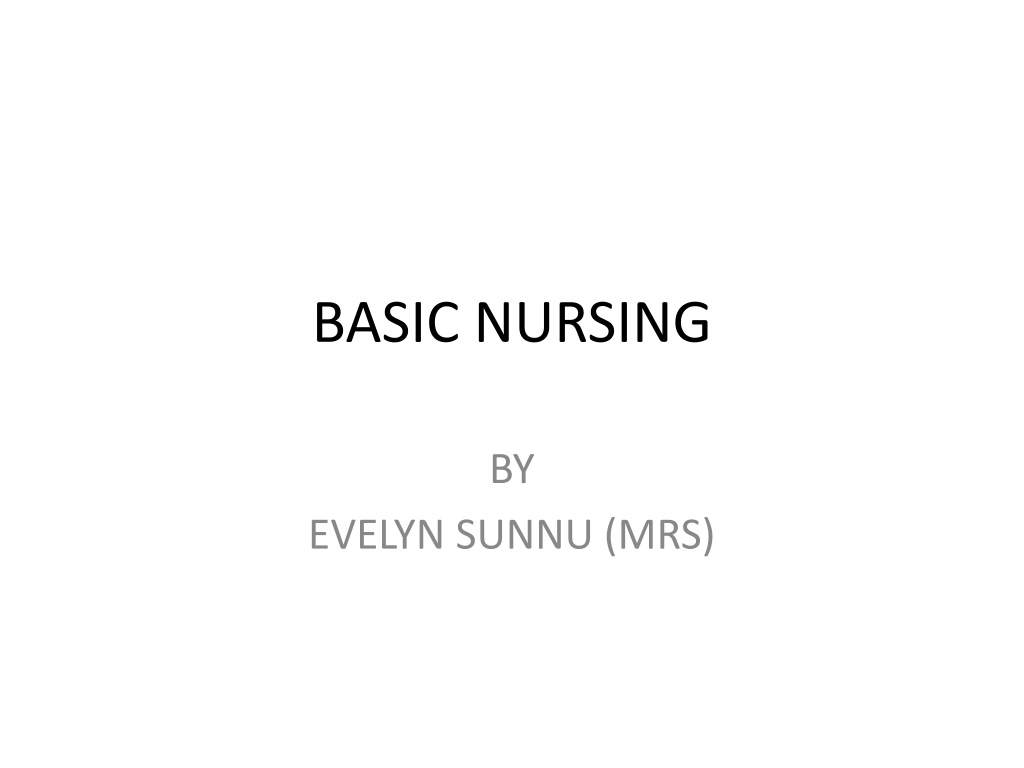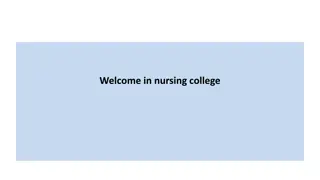Evolution of Nursing Through History: Insights and Reflections
Nursing has evolved significantly over time, influenced by historical events and societal changes. From traditional roles rooted in caregiving to Florence Nightingale's impact on defining nursing, the profession continues to adapt. The importance of holistic care, client-centered practices, and the role of nurses in promoting comfort and safety in healthcare settings are highlighted.
Download Presentation

Please find below an Image/Link to download the presentation.
The content on the website is provided AS IS for your information and personal use only. It may not be sold, licensed, or shared on other websites without obtaining consent from the author. Download presentation by click this link. If you encounter any issues during the download, it is possible that the publisher has removed the file from their server.
E N D
Presentation Transcript
BASIC NURSING BY EVELYN SUNNU (MRS)
INTRODUCTION Nursing today is far different from what was practiced years ago and it is expected to continue changing during the 21stcentury. To comprehend present day nursing and to prepare for the future, one must understand not only past events but also the sociological and historical factors that affect it
Womens Roles Traditional female roles of wife, mother, daughter, and sister have always included the care and nurturing of other family members. From the beginning of time, women have cared for infants and children thus, nursing could be said to have its roots in the HOME. Traditional nursing role has always entailed humanistic caring, nurturing, comforting and supporting.
Womens Roles Throughout history, wars have accentuated the need for nurses. During the Crimean War in 1854-1856, the inadequacy of care given to soldiers led to a public outcry in Great Britain. The role Florence Nightingale played in addressing this problem is well known
DEFITION OF NURSING FLORENCE NIGHTINGALE defined Nursing nearly 150 years ago as the act of utilizing the environment of the patient to assist him in his recovery (1860/ 1969). She considered a clean, well-ventilated and quite environment essential for recovery. In the latter half of 20thcentury, a number of nurse theorist have developed their own theoretical definitions of nursing such as;
DEFINITION CONT. Nursing is caring Nursing is an act Nursing is a science Nursing is client centered Nursing is holistic
HOSPITAL BED BED is equipment used by patients/ clients; therefore it has to be design for comfort and safety. It should be adaptable to various positions as required. Hospital patients spend varying amount of the day in bed, so, its comfort is of considerable importance.
HOSPITAL BED To ensure this, the bed should be fresh, free from crumbs and creases. The pillows should arranged to give support where necessary.
THE BEDSTEADS Hospital bedsteads are usually made of metals with wire springs inside. Its smooth outline facilitates cleaning and prevents it from collection of dust and pathogens. The most common size/standard length is approximately six (6) feet, six inches (1.9m) by three feet 0.9 m (width) and it is placed five feet apart.
BED STEAD A hospital bed should be 65cm to 70cm (26 to 28 inches) from the floor, this prevents undue musculoskeletal strain on the nurse and the client. It has four wheels under it for easy movement.
MATRESSES The typical hospital bed consists of a firm mattress on a metal frame that can be raised and lowered horizontally. They are made up of latex foam, air, water etc. They are covered with a protective waterproof material that resists soiling and can be cleaned easily.
BOLSTERS They are stuffed with hair and feather. It is a long thick round pillow that is placed across the top of a bed under the other pillows.
BLANKETS These are made up of synthetics or wool. Functions they are used to provide necessary warmth for the patient without too much weight on him or her
COUNTERPANES They are made up of bright, durable and colorful material. They are light in color and in weight They are used to decorate the bed
COTTON DRAW SHEET These are made up of fairly heavy cotton material. The standard size is two yards and one and half yards long. They are placed under the patient buttocks across the bed to protect the bed linen from getting soiled. It is also drawn to give patient a clean cool fresh piece of sheet to lie on.
WATERPROOF DRAW SHEETS/ MACKINTOSH These consist of rubber, plastic sheet about thirty Inches Square with a piece of material stitched to each end. It is tucked in and held firmly under the cotton draw sheet to protect the bed from getting soiled.
BED LINEN / BED SHEET These are made up of cotton polyesters or linen. They are used to cover the bed. also to cover the patient to provide warmth
LONG WATERPROOF SHEET They are made of canvas or rubber. It is thick and long enough to stretch over the whole mattress with excess to tuck in at the top and bottom of the bed. to prevent the bed linen from getting soiled.
RULES FOR MAKING HOSPITAL BED Collect all requirements before starting. Two nurses are required and they should work in harmony, avoiding jerky movements and jarring the bed. Never cover the patients FACE with sheet or blanket. Never expose the patient
RULES FOR MAKING BED Call for extra assistance to lift the patient. Turn away from the patient, when shaking bed linen and pillows. Conversation during bed making should include the patient, not on personal matters between nurses
TYPES OF BED MAKING Simple bed Unoccupied bed Simple occupied bed Admission bed Operation bed
TYPES OF BED MAKING Cardiac bed Fracture bed Nephrotic bed Divided bed
TYPES OF BED MAKING Changing bottom sheet from top to bottom Changing bottom sheet from side to side Amputation bed above knee Amputation below knee. Bed for drying POP
REQUIREMENTS FOR MAKING SIMPLE UNOCCUPIED BED Two bed linen One counterpane One draw sheet One long waterproof sheet Two chairs One Waterproof Sheets
PROCEDURE/ TASKS Explain the procedure to the patient and provide privacy. Arrange two chairs back to back at the foot end of the bed and carefully place the well folded bed linen on it. Turn the mattress to prevent it from sagging
PROCEDURE/TASK Place the long waterproof sheet on the bed and tuck it in all rounds on the mattress. Place the bottom linen on the bed and miter/ envelop the four corners to secure the sheet on bed. Place the draw mackintosh on the bed, well covered by the draw sheet
PROCEDURE/TASK CONT. Place the top sheet on the bed and miter the corners. Place the counterpane on the bed to beautify it. Miter the corners as well. Thank the patient and remove the chairs. Document the procedure for continuity of care.
MAKING AN ADMISSION BED Collects, arranges items on trolley and sends to bedside Arranges items in order of use on a chair or heart table Places bottom sheet evenly on the bed Tucks the sheet evenly under the mattress at the top and bottom using enveloped corners
ADMISSION BED MAKING Places draw mackintosh across bed and covers with draw sheet Places long mackintosh on the bed Uses one bath blanket or sheet over and tucks in all around or folds under itself Places second bath blanket over the bed
ADMISSION BED MAKING Puts in hot water bottles if necessary Puts on top bed clothes Places counterpane loosely over the top bed clothes Tuck in the bed clothes on the other side Folds the bed clothes on the other side nearest to the door, leaving it open to facilitate quick admittance























